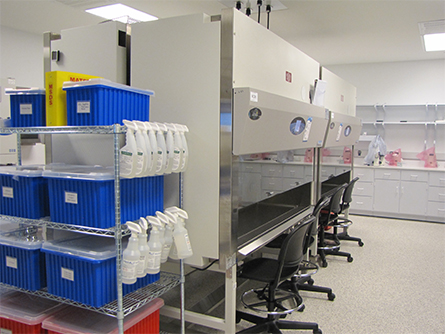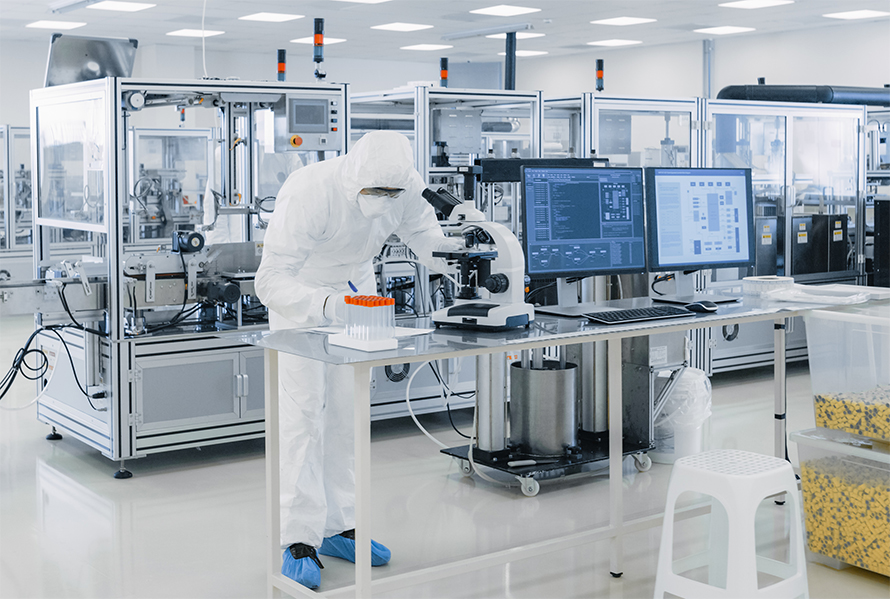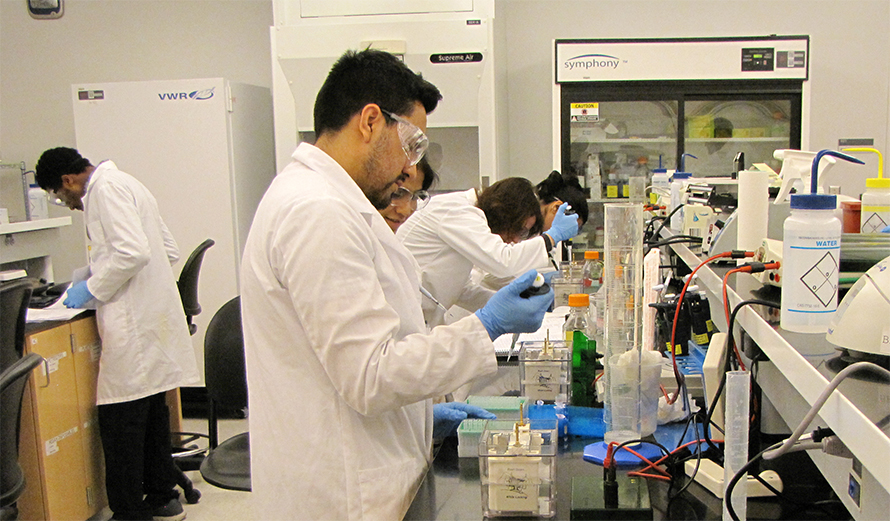On-the-bench training
When people talk about the challenges college students at primarily undergraduate institutions face getting into laboratories, they usually mean socioeconomic or related barriers to access. But at Montgomery College, the main barrier is the airlock.

in Maryland.
Swiping her badge to enter a biotechnology training facility during a virtual tour, Lori Kelman, a biotechnology professor at the community college in the Washington, D.C., suburbs, explained that the training lab was designed to mimic a pharmaceutical manufacturing facility certified by the Food and Drug Administration. After passing through an airlock with space to don sterile lab gowns, she swiped again to gain access to a row of closed biosafety cabinets with spray bottles of ethanol and disinfectant arrayed neatly alongside them and a pass-through cabinet in the wall to deliver media for cell culture from a clean room next door.
“Normally, when research scientists come in here, they say, ‘Wow, it’s so clean! It looks like you could eat off the floor!’” Kelman said. “And when industry scientists come in, they say ‘you’ve done a nice job’ — which means, ‘this is what we would expect an industry training place to look like.’”
Next door to the tissue culture room, the facility also includes a suite for isolating and purifying products from harvested cells.
“In case you were thinking community college meant the lowest level of available equipment,” Kelman said, pointing out benchtop instruments for droplet digital polymerase chain reaction and fast protein liquid chromatography in the downstream suite, “you would be wrong.”
Montgomery College has invested heavily in teaching biotechnology because the industry has become a significant economic driver in Maryland, a trend accelerated by the COVID-19 pandemic. Although the school has a large program, Kelman said, they’re nowhere near meeting the demand for entry-level biotech workers.
A new apprenticeship program may be one way of bridging the gap. Montgomery College recently began offering apprenticeships in biomanufacturing in partnership with pharmaceutical giant GlaxoSmithKline. Such programs, while still uncommon, are gaining traction as the biotechnology industry grapples with a significant labor shortage. Meanwhile, policymakers focused on getting Americans back to work and increasing economic productivity have proposed legislation that would invest billions in apprenticeships.
Labor market pressures in biotechnology
An apprenticeship is a full-time job that combines classroom instruction with on-the-job training to offer a route into a skilled trade, typically to high school graduates.
The Department of Labor, which has administered the U.S.’s registered apprenticeship system since 1937, defines apprenticeship as “an industry-driven, high-quality career pathway where employers can develop and prepare their future workforce, and individuals can obtain paid work experience and classroom instruction.”
In contrast to an internship, an apprenticeship is always paid, is usually registered with the government to ensure that it offers quality education, and lasts at least a year, usually several. Apprenticeships are common in manufacturing, construction, utilities, and health and safety industries.
Apprenticeships in the life sciences, on the other hand, are nontraditional. During a 16-year period when 1.5 million apprentices were trained, an analysis by researcher Daniel Kuehn and colleagues at the Urban Institute counted fewer than 950 apprentices in science, most of them learning horticulture.
But biotechnology and related fields are growing rapidly. Though the exact share of the economy varies among analyses, depending on what counts as biotech, the National Academies recently estimated that the bioeconomy generates 5.1 percent of U.S. gross domestic product, or almost $960 billion annually. Analysts project a growing number of what are called middle-skill jobs in the sector.
Many of those jobs will be in biomanufacturing, the use of cells or other living systems to generate products including food, nutraceuticals, biofuels, biologic medications, and cell and gene therapies. Once these products are discovered and proven effective, someone has to do the meticulous, repetitive work of producing them. The work requires excellent laboratory skills and troubleshooting but not a bachelor’s degree.
According to Karla Talanian, the director of talent and workforce development at the Massachusetts nonprofit MassBioEd, biomanufacturing “is an occupation that is fairly unique in the life sciences industry, where employers are already comfortable with hiring people who don’t have a four-year college degree.”
In fact, according to Talanian and to community college professors who run biotechnology programs, a bachelor’s degree in biology or biochemistry may not be the best preparation for entry-level industry jobs.
The purpose of a college education, and whether it should be the same as job preparation, depends on whom you ask. But according to Collins Jones, Kelman’s colleague on the biotech faculty at Montgomery College, “There need to be options for people who show an aptitude for science but maybe aren’t going to meet every science requirement that you would want for med school or grad school.”
Meanwhile, he said, what students learn in traditional courses “isn’t preparing them at all for industry.”
About half of the students in MC’s biotechnology program already have a four-year degree in the life sciences, Jones said, but lack technical and regulatory knowledge that would make them competitive for industry jobs. By way of example, he said, “We tell you how to denature a protein: (sodium dodecyl sulfate), heat, all that stuff. But then we go to the next step and say, ‘But really, if you’re making a monoclonal antibody, you want to avoid all that stuff.’”

The college then offers an introduction to best practices in protein formulation.
College graduates, according to both Jones and Talanian, frequently expect to do independent research and can become dissatisfied with the routine daily tasks of biomanufacturing. Often, the outcome is rapid turnover. To fill the resulting gaps, companies fall back on temporary contract workers. The arrangement, Talanian said, “leads to a lot of inefficiency in the system.”
Meanwhile, she added, competition for experienced workers across the life sciences industry is ferocious. “They’ve got recruiters calling them all the time. If they decide to put themselves out on the market openly, they get five job offers in a week. There’s tremendous salary inflation; there’s title inflation; and it’s just really not sustainable.”
To fill the need for biomanufacturing technicians, some companies and workforce development organizations have begun to experiment with apprenticeships.
Apprenticeships in biotechnology
Dolan Stimson had one goal when he was starting college: to earn his bachelor’s without going into debt.
At first, the Pennsylvania resident pictured himself as a high school chemistry teacher, and with his heavy-rimmed hipster glasses and easy smile, it’s not hard to imagine him at the front of a classroom. But as he worked through a teaching program at his hometown community college, he said, “It wasn’t a challenge that drove me. It wasn’t something I could see myself doing — maybe when I’m older.”
Instead, he considered becoming a pharmacist like his older brother. He took a few biotechnology courses and enjoyed them. Then he heard from his professor, Margaret Bryans, about a lunch and learn with a GlaxoSmithKline recruiter who was looking for applicants to join a new apprenticeship program.
GlaxoSmithKline is based in the United Kingdom, where apprenticeship is common. The company had approached Bryans, a professor at Montgomery County Community College in Pennsylvania and director of a National Science Foundation– supported biotech training program, to inquire about adapting its UK apprenticeship model to American labor markets.
(Montgomery County Community College in Pennsylvania, where Bryans is a professor and Stimson a student, is not affiliated with Montgomery College in Maryland, where Kelman and Jones teach. Both community colleges offer GSK apprenticeships through their biotechnology departments.)
According to Bryans, GSK had difficulty filling its manufacturing positions without offering additional training. “This is one of their tactics to develop that workforce,” she said of the program. “In their experience, young people who came on as apprentices tended to stay on long-term at the company.”
Anna Eswood, an early talent attraction specialist at GSK, said, “The apprentice program was very successful in the UK.” That success inspired the US program, she said, as “an approach to stabilize the pipeline of future engineers.” Stimson applied and, about a year later, was accepted into the first cohort. The program is designed to support apprentices through a three- or four-year course of study during which they earn an associate’s degree in biotechnology, with tuition paid by the company.
By the time Stimson started, he had completed his associate’s; the company supported his study for a bachelor’s degree in pharmaceutical product development. He earned a full-time wage, taking six credit hours a semester and working 29 hours a week as a chemical compound operator in training.
“Chemists want to create a drug. They have a synthetic route they want to use; however, they aren’t sure whether it can scale appropriately and safely,” Stimson said. “My role was to do that actual scaleup, still within the research side of research and development. … I’ve got to give a shout-out to Dr. Bryans, because her mock (good manufacturing practice) biotech lab was the single greatest experience in my education.”
Two apprentices have completed training in the MCCC/GSK biotechnology program, with two more about a year into their studies. According to Stimson, two of the four chemical operator apprentices who started when he did decided that the career wasn’t right for them.
“Since the program onset, we’ve had roughly 30 apprentices participate in the program across six GSK sites,” many of whom are still in training, Eswood said. Among them were apprentices learning to work as lab analysts, biochemists, instrumentation or automation technicians, and in other business areas such as logistics. The company’s biotechnology program is the oldest of five apprenticeship programs in biotechnology registered with the Department of Labor.
“I think what GSK is doing is going to serve as a test case,” Kelman said. “If it’s successful, I think you will see more.”
The industry may not wait to learn the outcome of GSK’s program. A flurry of additional biotech apprenticeships have launched or been announced in recent months. In North Carolina, a small company called KBI Biopharma announced a new program in pharmaceutical manufacturing. In Massachusetts, Talanian’s organization, MassBioEd, welcomed its first cohort of 19 apprentices in biomanufacturing to the classroom on June 1 and launched a clinical trials apprenticeship program in August.
MassBioEd targeted midcareer workers in Boston who wanted to move into more lucrative biotech fields, recruiting applicants with experience in traditional manufacturing, commercial kitchens or other areas that might offer transferable skills. After some prescreening, the organization forwarded promising applications to the five biopharmaceutical companies that sponsor the program. Candidates who made it through the companies’ vetting processes were offered jobs contingent on completing a five-month training program in classroom and lab.
For companies, supporting apprenticeship programs such as MassBioEd’s is a workforce development measure. They aim to reduce turnover and build local talent pools specifically trained for the jobs they are offering. Because apprenticeships tend to increase wages and employment, they also appeal to policymakers; the training model has seen an unusual degree of bipartisan support despite Washington’s polarized atmosphere.
Current and proposed legislation
“Registered Apprenticeships are this nation’s most successful federally funded workforce development initiative,” according to a statement released by U.S. Rep. Robert C. Scott, D-Va., who chairs the House Committee on Education and Labor. “Investing in Registered Apprenticeships ... strengthens our economy and helps employers build pipelines of talented and dedicated workers. Yet, Congress has not reauthorized the National Apprenticeship Act since it was first passed in 1937.”
Advocates for increased funding cite benefits to both apprentices and their employers. The average starting salary for someone who has completed an apprenticeship is $70,000, nearly twice the average salary for a high school graduate. One analysis found that for every dollar spent on an apprenticeship, employers get an average of $1.47 back in increased productivity, reduced waste and greater frontline innovation.
Policymakers are familiar with this economic case. In 2016, the Obama administration spent $90 million to increase apprenticeship access nationwide. Most of the money went to state apprenticeship agencies, with about a third supporting workforce development organizations, industry associations and companies to start new programs. (GlaxoSmithKline joined an associated group called Leaders of Excellence in Apprenticeship Expansion, Development and Research in 2018.)
As members of Congress sought to boost economic recovery after pandemic-related shutdowns, H.R. 447, the National Apprenticeship Act of 2021, passed in the House of Representatives by a vote of 247–143 in February. The bill, which enjoyed an unusual degree of bipartisan support in a highly divided Congress, proposes to invest $3.5 billion over five years to create nearly 1 million new apprenticeship opportunities, and includes language focused on dismantling barriers to employment for individuals impacted by the criminal justice system and individuals with disabilities.
In a statement released before the House passed H.R. 447, House Majority Leader Steny H. Hoyer, D-Md., said, “This legislation will help us provide opportunities to the millions of workers and their families who are out of a job due to COVID–19 and looking to reset their careers in order to reach for greater economic security.”
Since February, the bill has been under consideration in the Senate Committee on Health, Education, Labor and Pension, which has taken no action on it.
While the National Apprenticeship Act languished in the Senate, Rep. Rick Larsen, D-Wash., introduced another bill with a narrower scope, called the American Workforce Investment in Next Generation of Students Act, in late July. This bill specifically targets high school students who are interested in science, technology, engineering and math. If passed, it would establish a six-year pathway for high school students to go through community college and into registered STEM apprenticeships.
As this issue of ASBMB Today went to press, it appeared unlikely that either bill would be enacted before the end of the legislative term. Still, according to Kathleen Weiss, the interim head of a Baltimore training center called the BioTechnical Institute of Maryland, the prospect of expansion of funding for apprenticeships has many people in workforce development circles chattering.
A pathway into STEM for underrepresented minorities
One policy argument in favor of apprenticeships is that they open opportunities for well-paid careers in the sciences to people who face high barriers to college education. According to statistics from the Urban Institute, the skilled technical workforce, a classification for jobs served by apprenticeship, is the most racially and ethnically diverse scientific workforce in the U.S.
The origin story of the BioTechnical Institute of Maryland, or BTI, showcases the role that on-the-job training in lab skills can play in opening doors for underrepresented workers.
In 1998, Margaret Penno, a Johns Hopkins University School of Medicine professor, was experiencing high turnover among technicians in her research lab. Jean Smith, who worked in the building’s housekeeping staff, applied for the job.
“What is a research technician? I did not know,” Smith recalled in a video produced by Hopkins. “All I knew was that it was a better-paying job and that I was going to be using my mind, instead of my hands.”
Without a college degree, Smith was an unusual candidate for the job — but she turned out to be an excellent one and worked as a lab technician for almost 30 years until she retired, earning a college degree along the way. Her experience inspired Penno to start BTI as a way for other workers to transition into laboratories.

As a rule, apprenticeships, including in the sciences, skew heavily male. Most BTI trainees, however, are women of color; Weiss estimates that they are, on average, in their early 30s. Most work nights while taking morning classes in BTI’s lab.
“The majority of people that come to us are older women who have been (geriatric nursing assistants) their whole career,” said Tim Fawcett, the scientific director and an instructor at BTI. “That’s a very tough business. They come in, their back is hurting, and they just can’t do it anymore.”
Many patient care workers see developing medicines as a logical next step after nursing becomes too physically taxing, Fawcett said. Jobs in biotechnology, he added, tend to offer higher pay and better benefits than elder-care jobs.
“When we first started, I think Dr. Penno’s idea was that this would be for ... academic laboratories and medical schools,” Fawcett said. “But we’re getting a lot of people into industry now.”
Of the more than 500 BTI graduates, some 78% have landed jobs, many in small biotechnology companies, of which Fawcett said Baltimore has dozens.
Some of BTI’s efforts have not been as successful as hoped. When BTI partnered with Hopkins and the East Baltimore Development Initiative to offer training that would prepare neighborhood residents to work in a new research park the university developed, they found that academic spinoff companies overwhelmingly preferred to hire college graduates.
“Academic institutions ... are degree-conferring institutions,” Weiss said. “Even though our founder from Hopkins was pretty enlightened, sometimes it can be difficult to change the system within which you’re working.”
Unable to place many of the trainees in the research park, BTI staff helped them find biotechnology jobs elsewhere in the city. The episode illustrates a problem with job training. The Urban Institute’s Daniel Kuehn, who focuses on workforce development, said, “The concern with job training is always: You’ve gotten your training; now is there a job at the other end? Apprenticeship just doesn’t have that problem.”
A company that hires an apprentice hopes to retain that person when their training is complete, he said.
Funding for BTI is a perennial problem. The prospect of increased federal apprenticeship dollars and guaranteed job placements is exciting for the organization. Weiss said leaders hope to partner with local companies to offer classroom instruction and handle apprenticeship registration and reporting requirements.
According to Kuehn, such a service will be welcome. Some small companies hesitate to offer apprenticeships, because registering a new program involves a lengthy application detailing a training plan and wage structure, which sometimes must be revised before it is accepted. “Intermediaries that can help guide (companies) through that process ... help a lot,” he said. “The other strategy is group apprenticeship programs, where they can sign on to standards that already exist.”
Who are apprenticeships for?
The average American entering an apprenticeship program is about 29, although Kuehn said the number of college-aged students entering these programs has increased modestly. “Youth apprenticeship seems like a successful strategy for bridging the gap between school and work, and catching people that haven’t had successful transitions,” he said.
According to Kuehn, some policymakers worry that expanding youth apprenticeships as an alternative to college will encourage tracking that, like academic tracking in K–12 schools, could reinforce unequal socioeconomic patterns. He argues, however, that apprenticeship doesn’t preclude college; many apprentices are students.
According to Kelman and Bryans, recruiting college-aged students into biotechnology apprenticeships can be a challenge. Kelman chalks this up to an emphasis on exploration in the American education system compared to European systems and pressure for students to seek four-year degrees, especially in her affluent and highly educated region near Washington, D.C.
“A lot of times I’ll meet with a student ... and think, ‘My program is perfect for this particular student,’” Kelman said. “They’re telling me they want a job; they don’t have a lot of money for education; they don’t want a lot of student debt. But they don’t always choose it, and I’m not sure why.”
Meanwhile, according to Talanian, younger job seekers also can give hiring managers pause. “One of the things that employers tell us all the time is that they really want people with experience,” she said. In part, that was why MassBioEd designed a program to retrain mature workers. “They’re very hesitant to hire somebody who’s fresh out of high school.”
Irrespective of a worker’s age, Kelman said, an apprenticeship need not be their last educational experience.

Many employers support continuing education, helping cover tuition as workers study part-time for bachelor’s or master’s degrees.
Stimson briefly considered such a step after completing his apprenticeship early in 2020 but ended up pursuing an educational opportunity within GSK. Although he was guaranteed a job as a journeyman chemical operator at a salary GSK reported to the Department of Labor as $25 an hour, Stimson found that, like teaching, the job did not offer the challenge he was looking for. So he worked with a colleague to secure a secondment, a six-month assignment for permanent employees that, like apprenticeship, is more common in Europe than in the U.S. Working with a functional genomics research team, Stimson honed his molecular biology and tissue culture skills while applying for research positions at GSK and other companies.
Jones and Kelman both stressed that a person who gets into the biotech industry via a biomanufacturing apprenticeship need not stay on the production line forever. Along with opportunities for further education, both mentioned opportunities to grow into other roles within a company.
“What I’m trying to push everywhere I go is that there should be two paths that you can jump on and off,” Jones said. “Maybe, when you’re in industry, you’ll jump back on” to an academic path.
“Our big message now is that biotech is a career,” he added. “You’re not resigned to being a lab rat. ... It’s a career with lots of options that you can go into.”
Poised to boom
After his secondment ended, Stimson started work as a contractor assigned to Merck, where he is a biochemist testing products for problems. Although he chose not to stay at GSK, he said his experience there made him a more competitive applicant.
“A lot of the people I work with, they have master’s degrees and this is their first job,” he said. “I feel … honored, I guess you could say, to be considered with other students who had masters’ coming out of college.”
Asked whether he would recommend apprenticeships, Stimson gave an enthusiastic yes. “My whole goal when I graduated high school was to graduate college without debt,” he said. “That opened up options to do other large life choices — like, I was able to get married during that time.”
Apprenticeships in biotechnology are relatively unknown. But thanks to interest from policymakers and donors, and especially if the National Apprenticeship Act passes, their numbers are poised to grow. According to Bryans, whether or not the bill passes, apprenticeships are likely to proliferate.
“The workforce needs are only expected to rise,” she said. “With or without the bill, there’s such a demand for these technicians that companies ... are going to be coming up with it themselves.”
Internship, apprenticeship, co-op: formal and informal hands-on training
Apprenticeship is just one of many models for on-the-job technical training, with varying degrees of formality and overlap.
Most Americans are more familiar with internships, which are less structured, shorter-term and sometimes unpaid. For a highly regulated industry, according to the Biotechnology Institute’s Timothy Fawcett, apprenticeships can be a better fit than internships, because they allow more time for training.
“If you’re making something that’s FDA-regulated, the intern spends their whole time reading standard operating procedures,” Fawcett said.
At GlaxoSmithKline, which offers apprenticeships and paid internships, early talent attraction specialist Anna Eswood said that the main distinctions between these programs are their length and their relationship to classroom instruction. “Apprentices are attending school while they’re working, and interns are taking the opportunity while on a break from school,” she explained.
Another training model is a cooperative education, or co-op, in which students work for an employer, earning academic credit between stints as a full-time student. Co-op work experience is a graduation requirement in some degree programs, especially in engineering, but the model is not used widely in the sciences. GSK offers co-ops too; the program lasts six months to a year, in contrast to three-month internships. Some academics compare training in graduate school to an apprenticeship, noting that trainees learn to do research on the job over a course of years from masters of the trade.
Displaced workers
Last summer, Montgomery College in suburban Maryland expanded its biomanufacturing job training program into an eight-week boot camp for restaurant workers who had been laid off during the pandemic.
“There’s been an added layer of available jobs due to the pandemic,” Lori Kelman, a professor in the program, said.
She recalled seeing an appeal on the news in spring 2020 for scientists to help out at Qiagen. “I think what they were hoping for, and got, were a lot of lab workers who were suddenly at home, who went on in and assembled test kits for them, which got shipped out really, really quickly.”
Meanwhile, her colleague Collins Jones watched the pandemic ravage the local restaurant industry through a Facebook group he belonged to. He recalled that an industry contact once had mentioned recruiting restaurant workers when short on labor, “because they know how to take orders, so they know how to document; they know how to clean; they know how to organize themselves; and they can follow directions,” Jones said.
Jones put together a short, intensive training course in biomanufacturing for workers who had been laid off during the pandemic. It covered the highlights of the college’s two-year associate’s degree in just weeks. Of the 12 people who started the program, 11 completed it, and five went on to accept jobs in biomanufacturing.
The program is a test case for the kind of retraining policymakers hope an expanded apprenticeship system will offer. Because apprentices continue to earn an income and are guaranteed employment, Urban Institute researcher Daniel Kuehn said, apprenticeship “hasn’t played a major role in services for displaced workers so far ... but I think it could be bigger, because it is ideal for a lot of these reasons.”
Enjoy reading ASBMB Today?
Become a member to receive the print edition four times a year and the digital edition monthly.
Learn moreFeatured jobs
from the ASBMB career center
Get the latest from ASBMB Today
Enter your email address, and we’ll send you a weekly email with recent articles, interviews and more.
Latest in Careers
Careers highlights or most popular articles

Mapping proteins, one side chain at a time
Roland Dunbrack Jr. will receive the ASBMB DeLano Award for Computational Biosciences at the ASBMB Annual Meeting, March 7–10, just outside of Washington, D.C.

Exploring the link between lipids and longevity
Meng Wang will present her work on metabolism and aging at the ASBMB Annual Meeting, March 7-10, just outside of Washington, D.C.

Upcoming opportunities
Calling all biochemistry and molecular biology educators! Share your teaching experiences and insights in ASBMB Today’s essay series. Submit your essay or pitch by Jan. 15, 2026.

Defining a ‘crucial gatekeeper’ of lipid metabolism
George Carman receives the Herbert Tabor Research Award at the ASBMB Annual Meeting, March 7–10, just outside of Washington, D.C.

Building the blueprint to block HIV
Wesley Sundquist will present his work on the HIV capsid and revolutionary drug, Lenacapavir, at the ASBMB Annual Meeting, March 7–10, in Maryland.

Upcoming opportunities
Present your research alongside other outstanding scientists. The #ASBMB26 late-breaking abstract deadline is Jan. 15.


